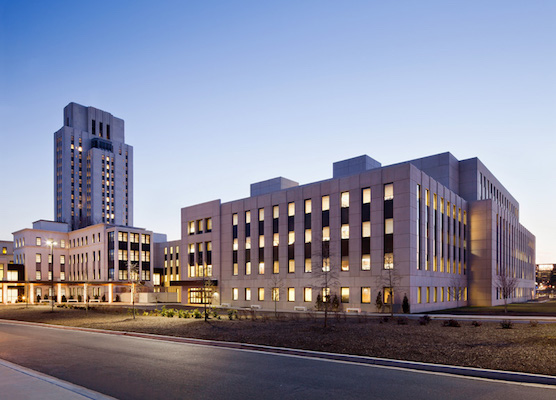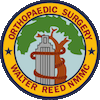Our Program
The Walter Reed Orthopaedic Surgery Program develops young physicians to be world class orthopaedic surgeons. Our home hospital is Walter Reed National Military Medical Center, the flagship institution for the Military Health System. WRNMMC is an academic medical center serving as the tertiary care referral center for mid-Atlantic region and beyond. It is a Level II Trauma Center, though we receive Medevac Missions from overseas with some of the most complicated orthopaedic injuries in the world. The program is designed to maximize exposure to all orthopaedic sub-specialties in order to create well-rounded, competent surgeons.
The Orthopaedic Surgery Department at Walter Reed has at least one fellowship trained attending in every subspecialty: Total Joint Reconstruction, Trauma, Spine, Foot/Ankle, Hand/Microsurgery, Sports, Shoulder/Elbow, Oncology, Pediatrics. In addition, we rotate at ten outside facilities to provide exposure to unique practice types, such as high volume arthroplasty and Level I Trauma.
Our Hospitals

| Year | Abbreviation | Months | Hospital | Location |
|---|---|---|---|---|
| Year 1 | WHC | 1 | Washington Hospital Center | Bethesda, MD |
| CNMC | 2 | Children's National Medical Center | Washington, DC | |
| WRNMMC | 9 | Walter Reed National Military Medical Center | Bethesda, MD | |
| Year 2 | USNA | 2 | United States Naval Academy | Annapolis, MD |
| WRNMMC | 10 | Walter Reed National Military Medical Center | Bethesda, MD | |
| Year 3 | Fairfax | 2 | Inova Fairfax Hospital | Fairfax, VA |
| WRNMMC | 2 | Walter Reed National Military Medical Center | Bethesda, MD | |
| CNMC or CHOP |
4 | Children's National Medical Center or Children's Hospital of Philadelphia |
Washington, DC or Philadelphia, PA |
|
| STC | 4 | Shock Trauma Center, University of Maryland | Baltimore, MD | |
| Year 4 | Research | 12 | Research Year: Walter Reed National Military Medical Center | Bethesda, MD |
| Year 5 | Sibley | 2 | Sibley Memorial Hospital, Johns Hopkins University | Washington, DC |
| WAMC | 2 | Womack Army Medical Center, Fort Bragg | Fort Bragg, NC | |
| Fairfax-Sports | 2 | Inova Fairfax Hospital | Fairfax, VA | |
| Fairfax-Trauma | 2 | Inova Fairfax Hospital | Fairfax, VA | |
| WRNMMC | 4 | Walter Reed National Military Medical Center | Bethesda, MD | |
| Year 6 | Belvoir | 2 | Fort Belvoir Hospital | Belvoir, VA |
| WRNMMC | 10 | Walter Reed National Military Medical Center | Bethesda, MD |
Our Curriculum
Adult Reconstruction
Dr. Robert McGillDr. John Cody
Dr. Robert Tracey
Dr. Sean Slaven
Sports
Dr. Christopher TuckerDr. David Streets
Dr. Marina Rodriguez
Dr. Kirk Hippensteel
Shoulder and Elbow
Dr. Kelly KilcoyneFoot and Ankle
Dr. Tobin EckelDr. Theodora Dworak
Trauma
Dr. Christopher RenningerPediatrics
Dr. Nicholas LopreiatoOncology
Dr. Benjamin Kyle PotterSpine
Dr. Melvin HelgesonDr. Scott Wagner
Dr. AJ Pisano
Dr. DJ Fredericks
Hand
Dr. Scott TintleDr. Banks Deal
Dr. Nicole Sgromolo
PGY 1 Year:
First year of residency and the transition from medical student to resident physician is challenging. This is when, under the guidance of your chief residents, you learn how to doctor. Residents take ownership of patients and patient care. At the same time, residents begin their formal training in orthopaedic surgery. They complete six 1-month rotations in orthopaedics. There are six non-orthopaedic 4-week blocks which include the following: plastic surgery, radiology/rheumatology, physical medicine & rehabilitation, general surgery trauma, neurosurgery, surgical intensive care unit. Finally, there is one 4-week block where interns are free from clinical duties and are immersed in foundations of orthopaedics. They learn the basics of plates and screws, they perform knee replacements and labral repairs on cadaveric specimens and compete to see who can perform the most robust fixation of a model forearm fracture.
PGY 2 Year:
Second year is largely regarded as the hardest year during residency. Residents are responsible for taking primary in house call while simultaneously starting to master surgical skills and clinical decision making. All 6 residents split the call responsibilities evenly, and are backed up by their chief residents. Ten of the 12 months during this year are completed at Walter Reed. The remaining two months are completed at the United States Naval Academy. The USNA is an invaluable learning experience for treating high level Division 1 Athletes. There is a huge volume of sports injuries, most notably ACL tears and shoulder instability. Residents work with the team physicians and attend USNA football games to learn how to manage athletes and on field injuries.
PGY 3 Year:
As a mid-level resident, responsibilities primarily focus on refining surgical skills. Most rotations are outside of Walter Reed except for 2 months which are spent on the trauma/oncology team. Four months of pediatric orthopaedic surgery is completed at either Children’s Hospital of Philadelphia, University of Pennsylvania (3 of 6 residents) or Children’s National Medical Center (3 of 6 residents). Four months of orthopaedic trauma is completed at Shock Trauma Center, University of Maryland. Two months of general orthopaedic surgery with an emphasis on trauma, sports and arthroplasty is completed at Inova Fairfax Hospital.
PGY 4 Year:
One unique opportunity at Walter Reed is the research year. One of the reason’s Walter Reed matches so many top tier fellowships spots each year is because of the emphasis on high quality research. There are pre-arranged research tracks available or you can create your own based on interests and passion. One resident is able to work in a peripheral nerve laboratory at Uniformed Services University which is supported by multiple post-doctoral fellows and research staff. Another will work with the DOD Trauma Database to continue to expand and learn from our war injuries. Another is able to conduct biomechanical and cadaveric studies. This is one of the most fun and productive years for residents.
PGY 5 Year:
During PGY 5 year, residents assume the senior resident role. The year is heavily operative but residents also begin to teach and mentor junior trainees. Each resident will complete either four months of total joints or four months of sports. The remaining 8 months are split evenly among a trauma rotation at Inova Fairfax (Fairfax, VA. Level I Trauma Center), a general rotation at Ft. Bragg (Fort Bragg, NC), a general rotation at Sibley Memorial Hospital (Washington, DC), and a sports rotation at Inova Sports Medicine (Fairfax, VA). The Inova Sports Medicine rotation offers residents the chance to work with the Washington Redskins and the Washington Nationals.
PGY 6 Year:
The chief year at Walter Reed is spent refining surgical skills and orthopaedic knowledge as well as serving as mentors for junior residents. Each resident will complete either four months of total joints or four months of sports, which ever one they did not complete during PGY 5 year. Six months are split among rotations at Walter Reed. These include 2 months on the Foot/Ankle and Oncology service, 2 months on the Hand service, and 2 months of the Pediatrics and Spine service. The final 2 months are completed at Fort Belvoir Hospital where chiefs are given autonomy to operate with an emphasis on sports and arthroplasty. Chief year allows residents to master surgical skills, prepare for the American Boards of Orthopaedic Surgery, and move forward to either work as an orthopaedic generalist or completing additional fellowship training.
Our Leadership
Program Director

Dr. Tobin Eckel
Orthopaedic Surgery Program Director
Walter Reed National Military Medical Center
tobin.t.eckel.mil@health.mil
Assistant Program Director

Dr. John Cody
Orthopaedic Surgery Assistant Program Director
Walter Reed National Military Medical Center
john.p.cody.mil@health.mil
Program Coordinator

Mr. Eric Brown
Orthopaedic Surgery Program Coordinator
Walter Reed National Military Medical Center
eric.l.brown24.civ@health.mil
Alumni Representative

Dr. Daniel Rodkey
Alumni
Walter Reed National Military Medical Center
daniel.l.rodkey.mil@health.mil
